It is just over a year ago now that I began to blog about my garden visits. The first was Robinson College, Cambridge and I remember being surprised it was open on 2nd January. It is still very much open for the NGS and I thoroughly recommend a visit: Robinson College
However finding myself back in Cambridge in that awkward time between Christmas and New Year I stumbled across yet another college garden. Having spent a happy morning in the excellent Fitzwilliam Museum I was just wondering what to do next and how to avoid the throng of ‘salesaholics’, when I found the 14th Century gate of Pembroke College conveniently open.
The site is made up of a series of interconnecting enclosed spaces and the well established gardens are very much part of the fabric of the college. I entered via the porter’s lodge on Trumpington Street (just left of the horses below).

Bird’s eye view by David Loggan 1690
Pembroke is the third oldest College in Cambridge and I began in the medieval Old Court. It was indeed a haven of calm, away from the jostling crowds of shoppers. The lawn, like green baize, stretched out serenely, so smooth it was of course strictly out of bounds. So I followed the paving right handed and walked towards the chapel.

A group of agaves huddled together seem to wave at me, and cause me to pause for a moment to read the many names on the war memorial tablet. The chapel here was Christopher Wren’s first building.
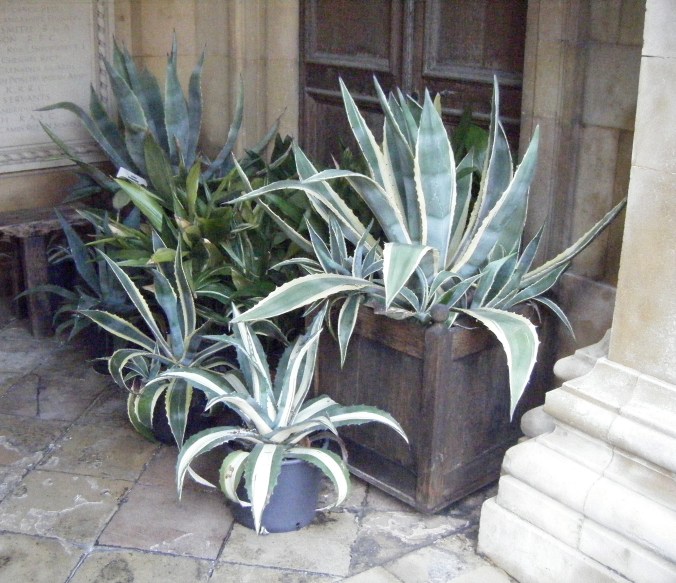
The upright growth of the Juniper ‘sky rocket’ seems to echo the tall chimneys, and although the little gate is closed,

access to the next court can be gained via a ramp; a simple feature and one I wish more gardens would employ; unless you have a wheelchair you have no idea of the importance.
So many roses are still flowering in December and will look even more colourful together with the catmint during the summer months.

Behind the chapel is the Victorian Red Building; four petalled flowers in stone grace the lower parts of the building,

whilst in the border across the lawn the real white petals of the hellebore are bright against the dark soil.

The crab apples of Malus robusta Red Sentinel look as fresh as they might in the autumn.
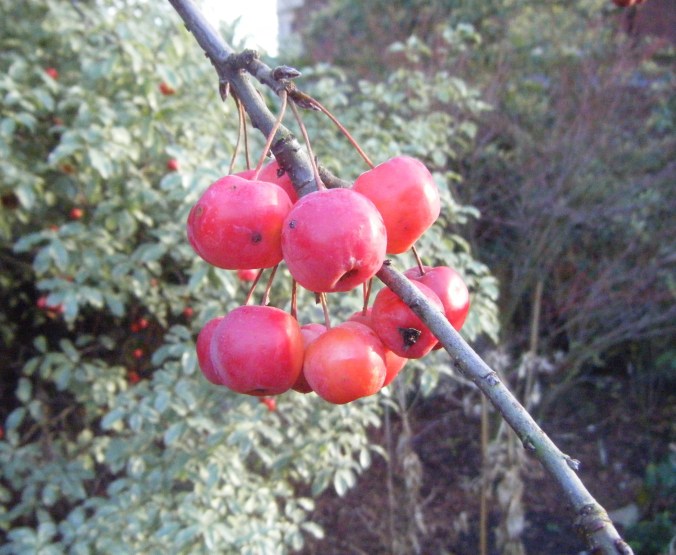
Moving round to the library lawn, I should show you the entire fine statue of William Pitt, who sits with his back to the library, but it is his foot that fascinates me pointing as it does towards the neat square turf.
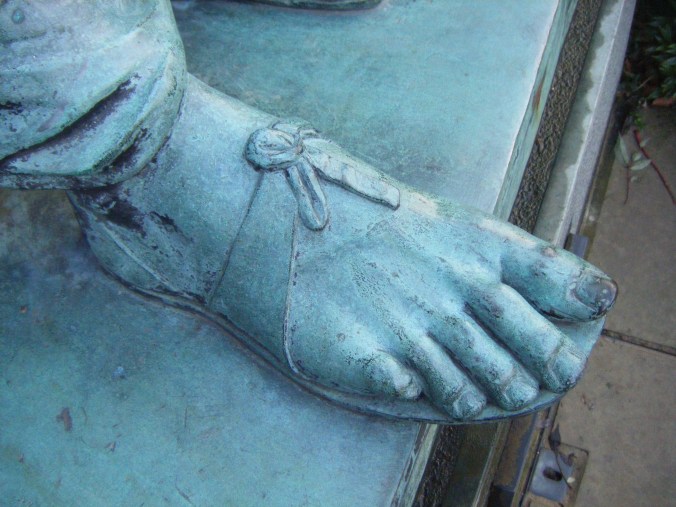
The gardener has been here for 50 years and the many varieties of well-tended shrubs cheer up a corner here and there and providing interest during these bland winter months; either grouped together,

or planted singly, like the bold and trusty evergreen Aucuba japonica, with its splattered leaves… did someone once spill their cream?

Choisya ternata ‘Sundance’ illuminates a shaded pathway,

and the bluish-leaved melianthus major makes a handsome combination with the purple-leaved pittisporum.

Nearby the berries of Nandina domestica are abundant and joyful. This is a plant that I had never previously come across, and am grateful for the coincidence that it is profiled in this month’s The Garden magazine.

I thought these were outdoor decorative christmas baubles until on closer inspection I realised that they were the dried fruits of the pomegranate, punica granatum.

Moving northwards away from the library court is an informal area, known as the Orchard. Medlars and mulberry grow behind the viridescent round pond which was created from a wartime water tank,
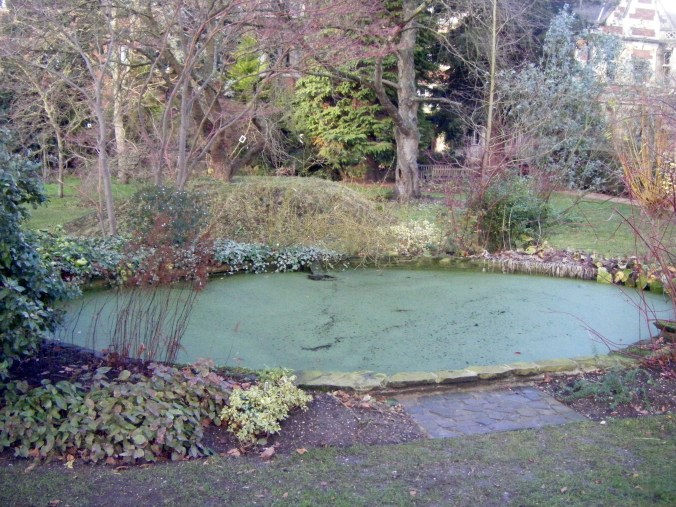
A great avenue of mature London Planes, their upper boughs a tangled pattern against the wintry blue sky.

An arbor provides a little mystery to the entrance of the Master’s Lodge. Whilst the nearby Fellows’ Garden remains closed today,
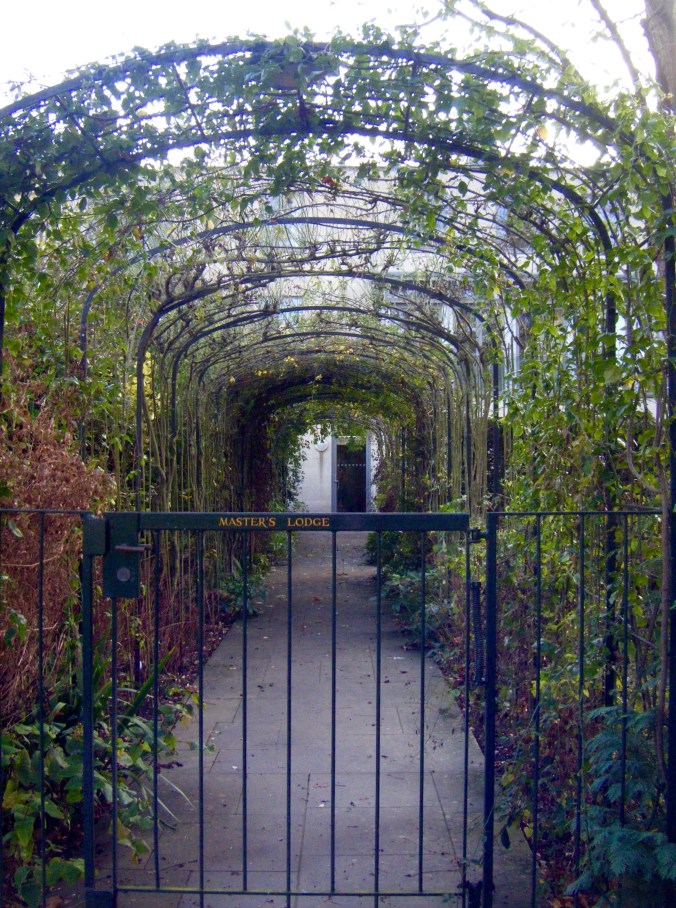
the Foundress Court bordered on two sides by the newest accommodation, is wide open and the Henry Moore Figure in a shelter 1983 is for all to admire.

Foundress Court has a strong connection with Nihon university in Japan, something which is perhaps suggested in the design of the inner courtyard.
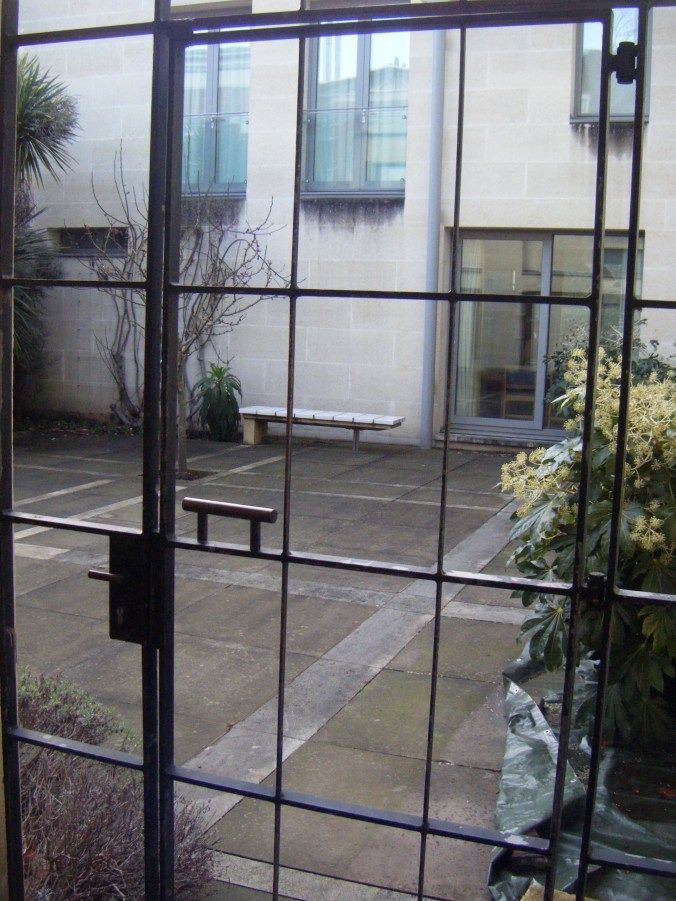
A simple pot, almost a modern still life, does much to break the monotony of the smooth walls.

Leaving the new build I walk towards the ancient bowling green; considered to be not quite the oldest in Europe it is however unique in having a ‘rub’, that is the ridge that runs down the centre. The green is only for Fellows to play which they do with wooden bowls that go back to the 18th century and are sliced rather than spherical. Notices implore us not to walk on this precious ground but there are plenty of benches placed all around for those of us who must be content to sit and admire.
The aged tulip tree Liriodendron tulipifera is bursting out of the paving.
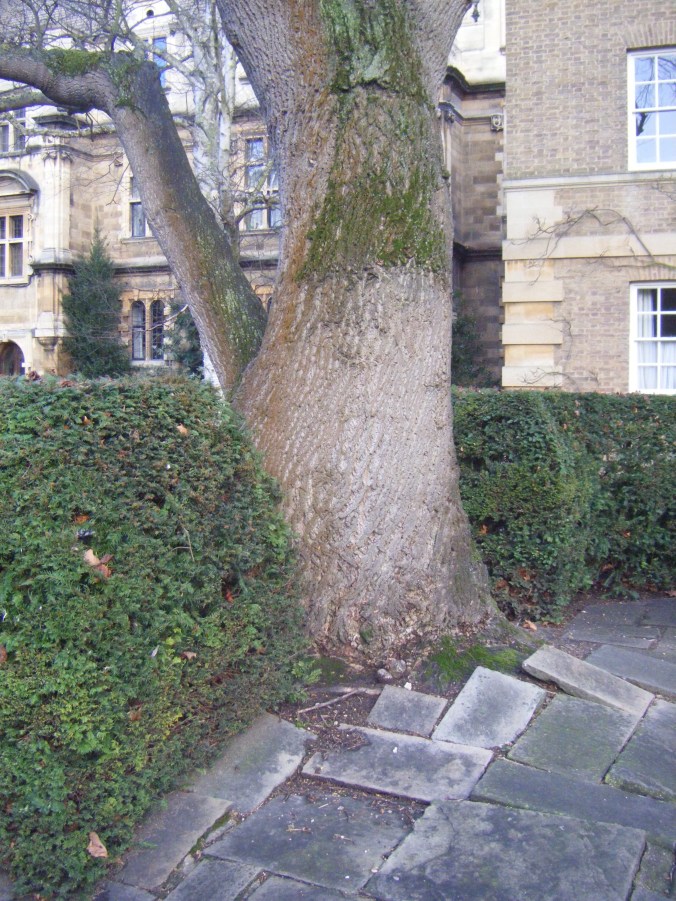
Over the hedge is New Court, originally built in the fourteenth century when it was known as First Court, where students play croquet on the lawn. A delightful area, it is surrounded on three sides by a low stone wall border made up of many unusual plants complimented by a delicious variety of decorative shrubs against the court walls:

The graceful catkins hang down from a Garry elliptica,

and the silvery grey Teucrum fruticans flows down to the paving.

A splash of colour is provided from the bright berries of cotoneaster.

Ridley’s Walk is named after Bishop Nicholas Ridley, one time student, Fellow and Master who was martyred in 1555 for his faith. I am sure the Bishop would be pleased with the diversity of plants growing along the walls which even includes a mature banana tree, Musa basjoo; obviously happy in the warmth of this corner it has been known to have borne fruit.
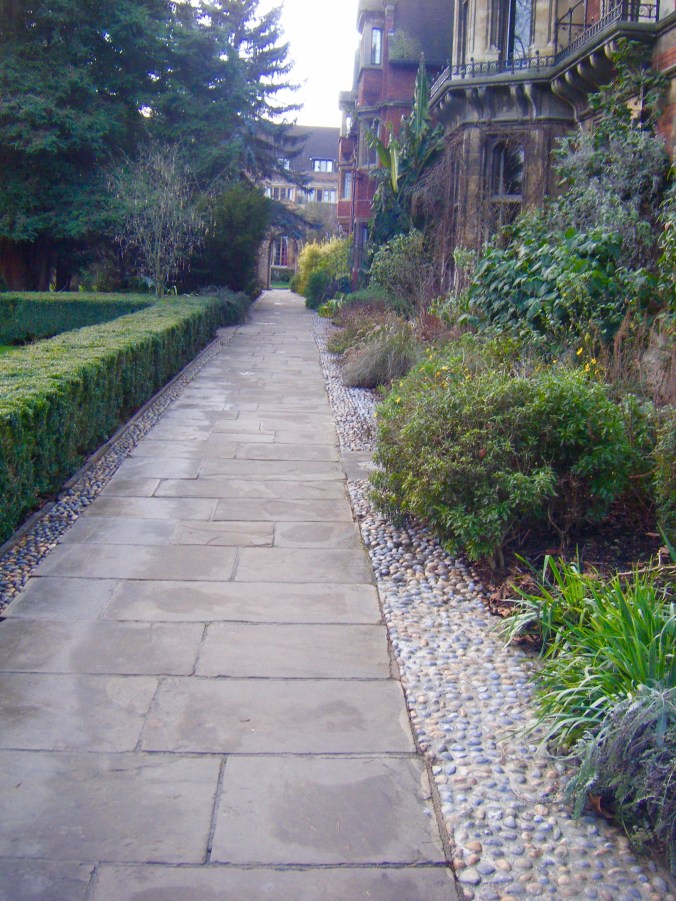
The walk leads into the final garden, Ivy Court. Simple in its layout with ten clipped yew, and four grass quads, there is in fact not a single leaf of ivy.

Another cunningly devised ramp takes you up into the arch.

Disabled access in fact ends here but it has been a delightfully easily-accessible garden, with it gentle ramps and smooth paths of generous width.

I am back at the beginning in the Old Court. Many Abutilon grow against the warm walls of this ancient college, and on this chilly but bright day this little gem looks particularly charming as it grows through the branches of a ceanothus.

And finally, there is the Solanum jasminoides, a member of the potato family; it looks most decorative on the window ledge under the reflecting pane of glass.

So much there has been to enjoy in this garden in mid-winter, and it could be said that if I had been allowed, I would have found many flowers to pick for a fine ‘nosegay’ today.
With new notebook in hand and a camera from Father Christmas I am all set to visit the many gardens to be open in 2018…
——-Jan 2018——-
So good to read about your visit to another college garden. I look forward to reading more of your wonderful blogs.
LikeLike
Julia- how nice that you’re going to continue somewhat. I so look forward to these little vignettes of gardens/
LikeLike
Let the touring begin. I enjoyed your walk around the University campus. The buildings look like a fairy tale setting. I am surprised at all the things blooming this time of year when I look out to see only snow. These flashes of color make me anxious for the growing season to begin. I can hardly wait until you post again.
LikeLike
What a joy The Garden Gate is Open again. I wish our lawn looked like the Old Court lawn. Looking forward to more gardens through the lens of the new camera.
LikeLike
We greatly enjoyed sharing your visits throughout 2017 and are delighted that you plan to go on treating all your followers to these delightful ‘virtual’ tours. Thank you very much for all the effort you put into making your blogs so interesting.
LikeLike
Thank you for your very kind comments
LikeLike
Oh hooray – so glad that 2018 will be uplifted by more of your visits!
LikeLike
Thank you for your continual encouragement
LikeLike
So pleased that thegardengateisopen is continuing in 2018. Fascinating detail as always and lovely to see that tiny bit of colour at this time of year.
LikeLike
Thank you for your kind comments and Happy New Year
LikeLike
Fabulous-I am thrilled you seem to be carrying on with your lovely blogs.
What a lot of winter interest there-so many tender species,such as the Echium(mine is swaddled up and still might die..) and agaves.
Well done -more please!
Irene CO East Sussex
LikeLike
I was amazed to see how many tender plants grow at Pembroke and being in a frost pocket am rather envious!
LikeLike
Have just found your blog, have so enjoyed reading through your garden visits in 2017 and will look in more regularly to see which gardens you visit in 2018. My husband and I are big NGS garden visitors here in our beautiful County of Cornwall. Thank you .
LikeLike
Thank you so much for your kind comments I really want to come and visit Cornwall. If you press the follow tab you will receive automatic updates.
LikeLike
Got to your blog at last. Looking forward to some happy reading.
Nesty
LikeLike
Ha ha I am glad
LikeLike
What a beautiful tour. Love the stonework, arbor and Henry Moore sculpture especially.
LikeLike